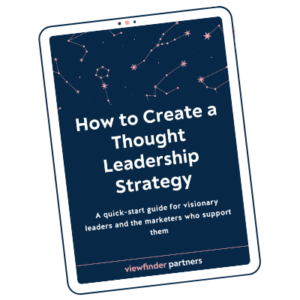If someone read your website’s homepage today, or if they clicked through your CEO’s latest keynote slides, or they got a peek at the big campaign you’re about to unveil…what would they say? What questions would they ask? Would they have any kind of reaction at all?
I’ve been thinking about a steady challenge in content marketing. It’s not a new problem, but it feels more pervasive than ever as more and more companies start “doing content,” outsourcing content, and putting content on autopilot.
I think of it as The “So What?” Factor.
So much of the content (web copy, articles, podcasts) I see sits comfortably in the exact middle of the road. It summarizes. It rehashes. It’s a wall of jargon that everyone else is using, but that doesn’t mean much. And more than anything else, it’s boring. I see the same ideas over and over.
And it all makes me say “So what?”
I see very expensive content campaigns, with promoted tweets and banner ads that follow me around and a million emails in my inbox and big, splashy virtual events tied to the campaign, but they’re so incredibly boring, so been-there-done-that, that they don’t even register. They’re static.
So what?
The other day, I read something from Doug Kessler at Velocity that made this trend pop out. He calls it “the missing mojo factor.” He says we have a mojo deficit in B2B marketing.
In his words:
Mojo is the thing that the best, smartest people in your company bring to work every day—but that somehow gets lost before you can get it to market.
Mojo turns a company into a crusade and a mission statement into an actual mission.
So what’s the antidote to the mojo deficit? How can we infuse some mojo into our content? How do we answer the “So what?” question?
I think you have two choices:
-
Think bigger.
-
Or…think smaller!
Think Bigger
First, think bigger. This is an exciting way to think about your content strategy or your next thought leadership focus.
I’ll use my go-to example — “future of work,” a phrase that’s so meaningless and overused but also so appealing to B2B marketers and founders. Let’s say your firm’s big idea right now is “the future of work.” Okay, fine. But how could you think BIGGER? How could you make it mean something and get out of the middle of the road?
Instead of just talking about or around the future of work, what’s your bold, brave vision for the future of work? What do you want to completely turn on its head, reject, or reimagine, in the not-so-distant future? What are you going to question? What are you going to bring back? When are you going to do it? Make some claims. Think bigger (in terms of the changes you want to make) and bolder (in terms of how you’re going to do it).
Think Smaller
Or, alternately, think smaller. Could you get really specific and detailed about the micro-changes you’re proposing in the future of work and the implications for real companies and the people who work there? Could you give real-world examples, with lists and sample schedules and templates? Could you show me exactly how to get to that future? What’s our timeline? Who’s going to be there? How are we going to do it?
The more details and specific ideas the better.
I know why people avoid thinking smaller. Going into the details means you have to choose a path and define your vision in clear terms. It means you have to branch off and take other options off the table. Your vision becomes less limitless. And it’s easier for people to poke holes in your argument if you get specific.
But the alternative? If you don’t think bigger or think smaller, no one will listen at all.
So the next time you’re prepping your Next Big Idea, push on it a little. If it seems a little boring or expected, a little “so what?”, think bigger. Or think smaller.






